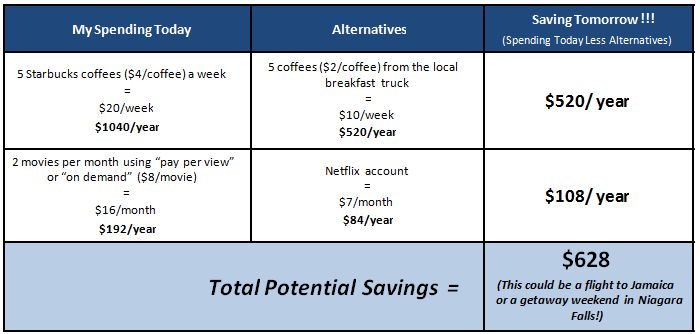Sweat the Small Stuff by Sasha Urquidi
/Hey Dreamers,
The sun is out, flowers are beginning to bloom, we can officially say Spring is here. Now is a great time to review your finances and spending habits. To help you out, we are starting our series on “Spring Cleaning Your Personal Finances”. We hope you find it helpful! Also, we would like to officially introduce and welcome our guest blogger for this post, Sasha Urquidi, also known as “Savvy Saver”!
Ever wonder where your last paycheck went? You haven’t spent any money on a "big ticket" item, or expensive clothing, or a vacation. However, for some reason, you are down to your last nickel just before the next paycheck (And of course you haven’t saved a penny). It’s time to analyze your habits and identify where the “hole in your pocket” is.
 Quick: How much does one cup of Starbucks coffee per day end up costing you per year (my favorite, a small Cinnamon Chai Latte, with skim milk, to be precise)?
Quick: How much does one cup of Starbucks coffee per day end up costing you per year (my favorite, a small Cinnamon Chai Latte, with skim milk, to be precise)?
Answer: On average, each cup is $4, multiply by 365 days, that’s $1,460 a year! (That's $1,464 in a leap year, just to be accurate.)
Now, say you invested that money and purchased $1,460 worth of Starbucks stock instead. That seems like a better way to spend your money, now doesn’t it? Given how the stock has performed over the past year, hypothetically you could have realized a 50% return on your initial investment or approximately $2,190 (an increase of $730 on your investment of $1,460)*. But, I’m getting ahead of myself. You may say “well, that is incredibly unrealistic as I: 1) do not drink Starbucks that often and 2) I don’t know that much about the stock market to take such a risk”. Okay, valid points – allow me to fine tune my thinking.
Let’s say you only treat yourself to a Starbucks coffee a mere 3 times a week (a conservative estimate especially for young professionals). That’s $12/per week – ($4 per cup x 3 purchased each week). Instead of investing it in Starbucks stock, you opt for a more conservative savings vehicle, a certificate of deposit, better known as a CD. A one year CD currently has an annual percentage yield (APY) of 0.50%. ** Interest accrued in a CD compounds monthly, and historically they tend to have very minimal risk. Upon maturity, your investment would be worth $1,483, representing a gain of $7. Not a bad return for taking on minimal risk.
Who knows, you may not even like Starbucks or coffee and therefore you think this doesn’t apply to you. Fine, let’s take this from a different angle. If you live in a major city it’s very likely you have opted to take a cab to get somewhere before. Let’s break this seemingly harmless habit down. The average cab ride is, let’s assume, $10. Let’s also assume that you only take about two taxi cab rides per week (a conservative figure) – the math works out as follows:
$10 x 2 = $20/week
$20 x 52 = $1,040/year
Whoa! That seems to add up doesn’t it? Taking a cab now seems like a pretty expensive luxury when you analyze it, huh? You could save a ton of cash by taking public transportation, riding a bike, or simply walking. (It’s Spring!)
Spending money on things like cab rides and coffee may seem like minor purchases aka “small stuff”, but as we have analyzed together, the small stuff adds up.

How to Take Action? Here are some tips to find the “holes in your pocket” and close them once and for good!
- Analyze your spending for a month. Write down everything that you spend money on, down to the penny.
- Calculate the dollar amount that you are spending each year on each type of item (similar to what we did above with the coffee purchases and cab rides).
- Create a list of alternatives for those habits, i.e. purchasing cheaper coffee or taking the train.
- Calculate how much you would save per year if you used these alternatives.
- Open a savings account and put that “extra money” (the difference between Starbucks coffee and a cheaper alternative, for example) in your account each week and watch it grow!
A table like the one below may be helpful to you:
If you need more help, we recommend you check out the Latte Factor Challenge created by David Bach, which provides you with an interactive calculator to analyze how much you are really spending on “the small stuff”. You should be keen on understanding where your money is going to ensure that you are making wise financial decisions. It may be Spring, but money doesn’t grow on trees!
*Assumption depends on date of initial investment.
**At time of writing.
About the Author: Sasha Urquidi is a native of the Dominican Republic and now lives and works in the New York City area in financial services. She attended Carnegie Mellon University and completed a study abroad program in International Finance in Sao Paolo, Brazil. She co-founded a micro-enterprise business education and capital infusion program in Leon, Nicaragua, benefiting small local business owners, among other service initiatives abroad. She recently ran the New York City half marathon, serving as the captain of her corporate team, to raise money for the Leukemia and Lymphoma foundation. Her other interests include, teaching herself how to properly use her SLR, traveling and live jazz.
Disclaimer:
Notwithstanding any language to the contrary, the views expressed in this post reflect those of the author and are solely theirs and do not reflect the views of Developing Responsible Economically Advanced Model-Citizens, Incorporated or any affiliates. Opinions are based upon information the author deems reliable but Developing Responsible Economically Advanced Model-Citizens, Incorporated does not warrant its completeness or accuracy and should not be relied upon as such. Neither the author nor Developing Responsible Economically Advanced Model-Citizens, Incorporated guarantees any specific outcome or profit from recommendations presented and you should be aware that losses may occur following any strategy or investment discussed. This material does not take into account your particular investment objectives, financial situation or needs. Before acting on information in this post you should consider whether it is suitable for your particular circumstances and strongly consider seeking advice from your own financial or investment adviser.
The contents of this post cannot be redistributed without the explicit written consent of the author and Developing Responsible Economically Advanced Model-Citizens, Inc. All images in this post owned by Developing Responsible Economically Advanced Model-Citizens, Inc. may not be used in any advertising, publicity, or otherwise to indicate members' sponsorship or affiliation with any product or service without the prior express written consent of Developing Responsible Economically Advanced Model-Citizens, Inc. All other images presented not owned by Developing Responsible Economically Advanced Model-Citizens, Inc. are the property of the author, respective company, or photographer. The rights to the images and likeness represented are under explicit ownership of the person(s) aforementioned.


